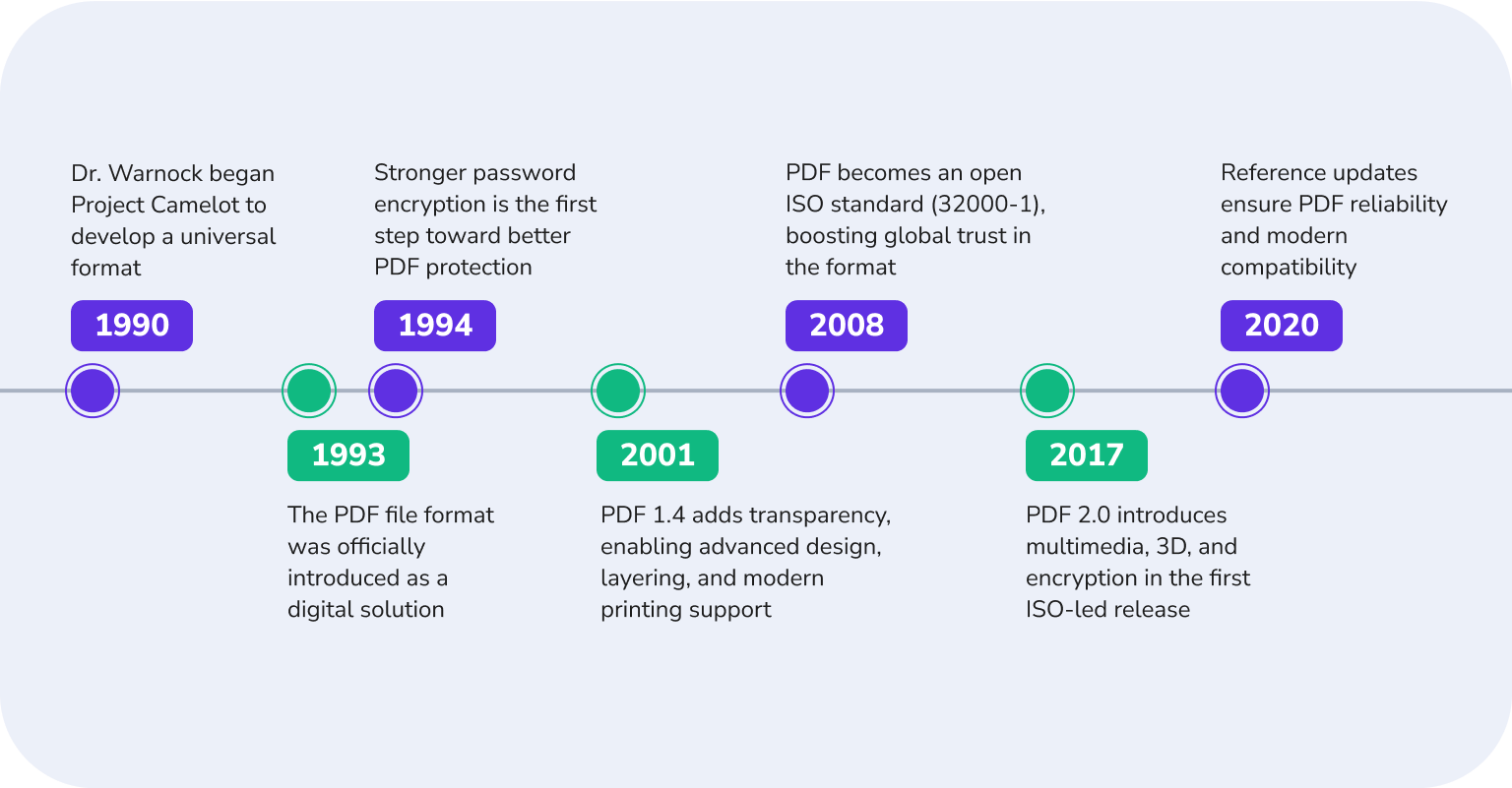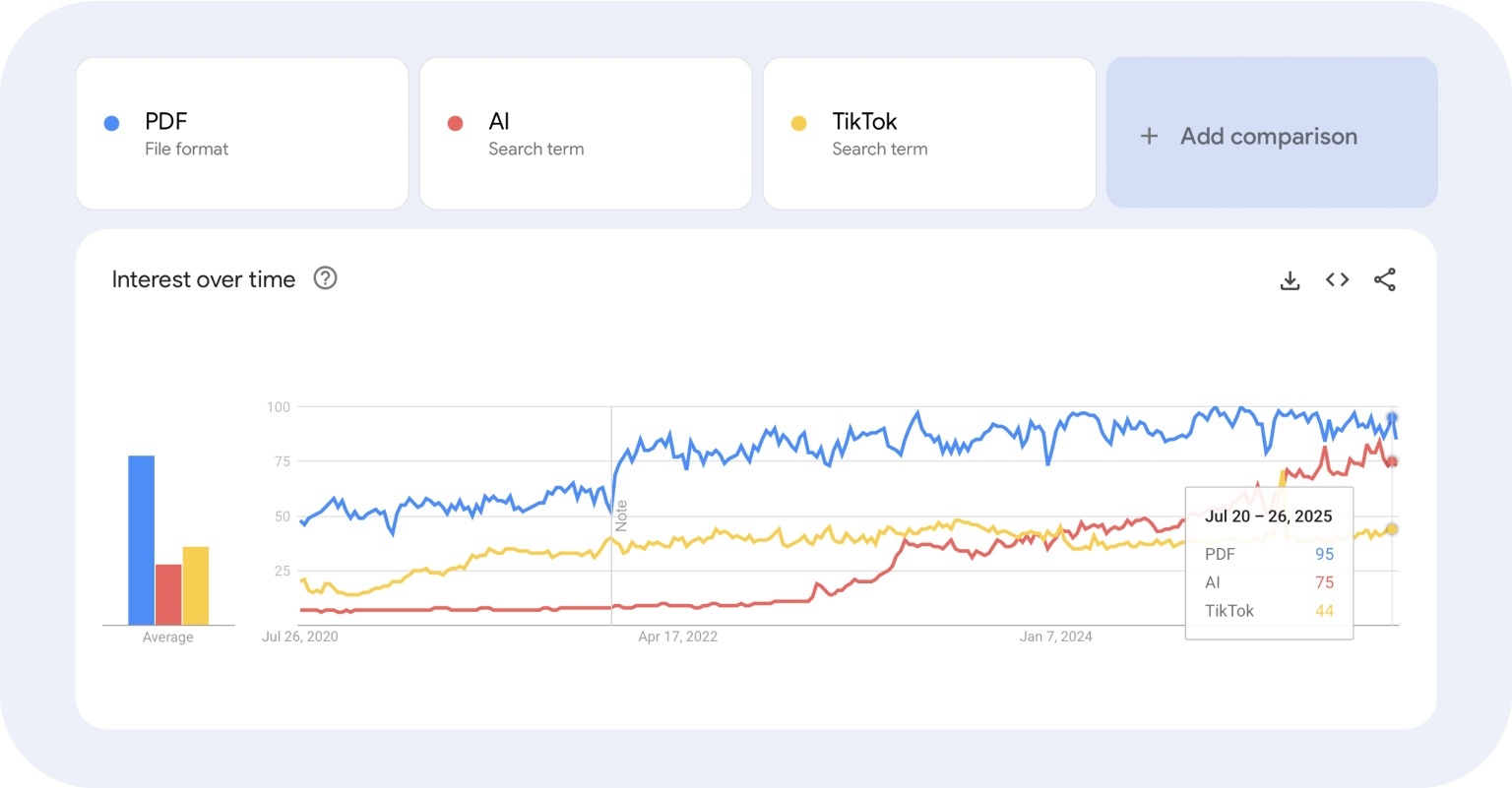The article explores how PDF has grown from a simple way to preserve document layout into a global standard for sharing, securing, and storing digital documents. It shows how AI, blockchain, and cloud tools make PDFs smarter, easier to use, and better suited for today’s mobile and remote work needs. The article outlines how PDFs are set to remain a key format, with greater automation, stronger security, and richer interactive features over the next decade.
It has been over 30 years since the introduction of PDF, which changed the way we work and made the paperless office commonplace.
But PDF’s story is remarkable; it has become a universal technical standard, now enhanced by artificial intelligence (AI). This “digital move” has improved efficiency and reduced our reliance on paper.
Looking ahead, we’ll work with PDF documents in new ways. AI-powered tools, including natural language processing (NLP) and machine learning (ML), are changing how we read, organize, share, edit, and present digital documents. This is the path we are now on.
History of PDF technology
Since its inception, the PDF format has evolved from a basic tool for preserving document integrity to a versatile instrument for digital communication.
Our PDF editor keeps up with changing market needs, so users can rely on advanced features. It is key in digital document management, helping organizations create, share, and protect files efficiently.
To see how PDF technology has reached this point, let’s look at the key milestones that shaped it.
1990 Adobe Systems co-founder Dr. John Warnock launched Project Camelot to develop a universal file format. The goal was to make sharing and printing documents work reliably on any system. As he put it, “What industries badly need is a universal way to communicate documents across a wide variety of machine configurations, operating systems, and communication networks.”
1993 The PDF file format was officially introduced as a digital solution. Adobe released Acrobat and PDF 1.0 in June 1993, starting a new chapter in how people create, share, and store documents.
1994 Improved password encryption is implemented for better security, marking one of the first steps to strengthen PDF’s protection against unauthorized access.
2001 PDF 1.4’s imaging model is extended to allow transparency, enabling more advanced graphic design, layering effects, and better support for modern printing and publishing workflows.
2008 PDF becomes an open international standard (ISO 32000-1), helping to build trust in the format among businesses, governments, and organizations around the world.
2017 PDF 2.0 is released with support for multimedia, 3D, and stronger encryption. It’s the first major update led by ISO without Adobe’s direct involvement.
2020 Key updates to normative references helped keep PDFs reliable and compatible with modern software.

Types of PDF formats
Initially, PDF was slow to gain traction due to its reliance on proprietary creation and viewing software. However, it experienced a significant boost in adoption when Adobe provided free access to Acrobat Reader in 1993. This move exponentially increased PDF usage, both on desktops and in online environments. As a result, the market was flooded with specialized tools for seamless PDF conversion and editing. Consequently, various PDF formats were introduced to cater to diverse user needs. We're talking about:
PDF/A is a special version of PDF designed to manage documents over the long term.
PDF/X works as a go-between for file sharing before printing. It also enables online checks before hitting the press.
PDF/E supports interactive media such as animations and 3D models, making it crucial for engineers.
PDF/VT is used for variable and transactional printing. Variable data printing lets users add small amounts of personalized information. Transactional printing, however, allows for larger amounts of personal data in a document.
PDF/UA ensures that PDFs are accessible to all users, including those with disabilities.
PDF 2.0, offers new and enhanced features, improving printing, encryption, annotation, digital signing, file embedding, and more.
Traditional document vs PDF management
The PDF format transformed document management, offering a digital alternative to the limitations of standard documents. A paradigm shift occurred.
| Feature | Traditional Document Handling | Changes with PDF’s Introduction |
|---|---|---|
| Conversion | Not possible with physical documents | Convert any format (e.g., Word, PNG) online easily |
| Accessibility | Limited remote access; difficult for people with disabilities | Easy access for all, including those with disabilities |
| Editing | Manual, time-consuming changes | Edit any document in seconds |
| Security | Risk of unauthorized access, data loss | AI security detects breaches, protects data |
| Archiving | Stored in boxes, hard to manage | Cloud storage, databases, instant search |
| Distribution | Hard to track, share widely | Easy sharing, works across devices, and secure |
| Productivity | Slow to review, edit, and update | Split, merge, comment, convert, summarize, collaborate |
Benefits of using PDF
Using PDFs ensures consistency in document presentation across different platforms and devices. It doesn’t matter whether you’re compressing your files, sharing statistical reports, presenting sales pitches, or composing contracts. It looks exactly the way you want it to, with your text, images, and formatting preserved.
Let’s see what else makes PDFs so useful.
Electronic signatures. Signing a PDF or filling out a form with an electronic signature offers the convenience of remote signing from any device. We suggest using our sign PDF tool to keep your data safe — it uses encryption protocols to protect your information.
Enhanced security measures. PDFs can be password-protected and encrypted to limit access to authorized individuals. This ensures better document security.
Digitization of documents. We’re talking about file converting here: whether it's text documents, spreadsheets, presentations, or images, our PDF converter has you covered. Excel, HTML, EPUB, TIFF — our list of formats is way longer.
Google trends
From 2020 to 2025, PDF consistently led global search interest compared to both AI and TikTok, showing its lasting importance in digital document workflows. A clear rise in PDF searches is visible starting in early 2022, as reflected in Google Trends data. While AI interest grew sharply from late 2022, PDF remained among the most searched terms.

PDF today: Modern use cases
Adobe 2021 Annual Report states that trillions of PDFs are created every year, showing how essential the format has become across nearly every part of the economy, from legal, finance, and publishing to many other fields.
According to Business Research Insights, the global PDF editor software market is expected to grow from USD 3.97 billion in 2024 to USD 17.71 billion by 2033, representing a CAGR of 18.09%.
With PDFs now central to modern business, companies are moving toward smarter ways of managing documents.
Future of the PDF format
AI enhancements
AI transforms how people work with PDFs by making common tasks faster, smarter, and easier. AI-powered redaction tools can now detect and remove sensitive information accurately, helping protect privacy and meet security requirements. When adjusting text, layout, font size, or style, AI offers helpful suggestions to keep formatting consistent, even in complex or shared documents. AI also improves navigation by using section names or links instead of page numbers, making it easier to jump to the right part of a long file.
Another example of AI in action is Adobe's Liquid Mode. Liquid Mode automatically reformats PDFs for mobile devices, making documents easier to read on smaller screens without losing important structure like headings or tables. AI can also summarize documents, showing the main points of long reports, contracts, or articles, and saving you time and effort.
OCR technology
OCR (Optical Character Recognition) technology allows users to convert scanned documents or images containing text into real, editable, and searchable content. This means text that was once locked in a picture or scan can now be copied, edited, highlighted, or indexed for search, making updates, annotations, and data extraction fast and simple.
This solution is now widely used by businesses, educators, and individuals to integrate old paper documents and scans into modern workflows, with PDF Guru’s OCR PDF tool being a reliable, user-friendly option.
Blockchain validation
Blockchain validation is a way to ensure a PDF’s authenticity and integrity by recording its unique digital fingerprint (hash) on a secure, tamper-proof blockchain. This approach is widely used in audit systems for enterprise records. After creating a PDF, its hash and unique ID are stored on the Ethereum blockchain. Later, the PDF’s hash can be recalculated and compared to the blockchain record. If they match, the document is proven to be original and unchanged. This approach is used in internal documents and estate management systems.
PDF accessibility & universal design
Modern PDFs are designed to be accessible so that everyone, including people with disabilities, can use them. When done right, they include things like headings, tables, alt text for images, labeled forms, and a clear reading order — all of which help screen readers and other assistive tools work properly. Good color contrast and consistent layout also make documents easier to read. PDF/UA (ISO 14289) defines these standards, and new AI-powered tools are helping creators meet them more easily.
Interactivity & rich media
PDFs are no longer limited to static text and images. The format now supports rich media like videos, 3D models, audio, and animations, allowing documents to deliver information in more dynamic and engaging ways.
This transforms how PDFs are used in fields such as engineering, architecture, education, and marketing. For example, 3D models can help visualize technical designs, while embedded videos can provide tutorials or product demos directly within the document. Interactive elements like forms, clickable diagrams, and navigation tools make it easier for readers to explore complex content.
PDF 3.0 (PDF/A-3): Key features & outlook
PDF/A-3 is part of the ISO set of standards for long-term document storage. It helps ensure that files stay safe, consistent, and easy to access over time. What makes PDF/A-3 stand out is that it allows other files like XML, CSV, CAD drawings, or images to be included inside the PDF. This means documents and related data can be kept together in one place. It’s widely used in finance, engineering, and compliance, where both documents and supporting data need to remain available and unchanged for legal or business purposes.
Frequently asked questions
When was PDF created, and who invented it?
Adobe created and launched PDF in 1993. The idea came from Adobe co-founder Dr. John Warnock, who started the “Camelot Project” in 1990 to solve document sharing and printing challenges.
Why is PDF still the standard format for sharing documents?
PDF has stayed on top because it keeps documents looking the same on any device, is easy to share securely, and works for both print and digital use. It’s also an open standard and continues to evolve with new features.
How is artificial intelligence improving PDFs?
AI is making PDFs smarter. It helps tag content for accessibility, chat with PDFs, summarize long documents, and improve search.
What makes PDF/A-3 (sometimes called PDF 3.0) important?
PDF/A-3 lets you include other files, like XML, CSV, or CAD, inside a PDF. This keeps documents and related data together, which is valuable for legal records, compliance, and business use.
Key takeaways & next steps
So, what's the future of PDF? We expect it to remain a key format for digital documents, with major changes expected over the next decade. AI technology will likely bring smarter features — from real-time summaries and automated compliance checks to better redaction and built-in accessibility.
Cloud-based and mobile-friendly PDFs will become the norm as remote work keeps growing. Blockchain validation could become standard for contracts and sensitive files.
While it’s unlikely any single format will replace PDF, we may see it work more closely with web technologies and open data formats to support richer, more flexible content. PDF editor tools will play a key role in this shift, helping users create, adapt, and manage documents that integrate with modern digital platforms.
Sources
2001: PDF 1.4 and transparency
